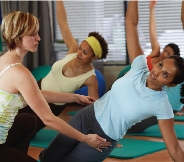Extensive Experience out of the Gate
The University of California, Santa Barbara, sets high standards for budding group fitness instructors.

Amy Jamieson, MS, academic adviser and lecturer in the department of exercise and sport studies at the University of California, Santa Barbara (UCSB), works with the future of fitness every day. She helps guide students in the fitness instruction minor, a program that includes theory, training and practical components in a range of health, fitness and club settings. “What makes this program remarkably different from other programs is the inclusion of extensive hands-on training,” according to the UCSB website. This training culminates “in a 10-week internship program [that provides] more than 160 hours of applied experience.”
How many existing fitness professionals can say they began their careers with as much knowledge already tucked under their belts? Read on to discover the details about this university program that is committed to refining professionalism in the fitness industry.
How long have you been
involved with this program? What kind of changes have
you seen during your tenure?
I have been involved in the fitness instruction minor program for over 12 years. I have seen the program grow with the addition of the personal training emphasis. The program keeps up with industry trends and changes, so it is constantly growing.
What are the main highlights of the curriculum? How do they prepare students for a career in the fitness industry?
The main highlights are the hands-on opportunities for students. In addition to the core science courses, students are required to complete more than 40 hours of practical training in the lab and over 40 hours of internship experience in the field. The practical application component really prepares students to enter the industry. Graduates leave UCSB with real experience and extensive knowledge.
How do you grade students or define program completion?
In addition to standard exams, students are being graded on practical application. They are required to submit case-study work and to document fieldwork hours, which include group training leadership, shadowing of fitness professionals, one-on-one client training and experience with special populations. Students obtain the minor degree by maintaining a 2.0 grade point average within the minor courses and upon internship completion.
How much of the program is practical (hands-on) and how much is theory?
The prerequisite courses include anatomy, physiology, nutrition and movement. Core classes include exercise physiology, kinesiology, sport psychology and athletic injuries. The hands-on courses are taken after completing the prerequisite and core science–based courses. The program is about 70% science and theory and 30% hands-on.
What are the major obstacles or challenges for your program? For the graduates?
The major obstacles are time and space. We need additional space to accommodate larger classes and more students. The students often want more courses and more time for internship opportunities.
What motivates today’s college students to enroll in fitness-
related programs? Do they
have traits in common that
distinguish them from other students? What attracts
them to your program?
The greatest motivation for students is an inherent interest and belief in health and fitness. We normally draw athletic, active students into the program. The students are attracted to the subject matter as well as to the opportunity to learn skills that prepare them for a job in fitness right out of the door.
Does your program have any network in place to link
program alumni with
upcoming grads?
We don’t have an official network in place. However, our alumni are very loyal and often maintain contact with our department and offer to help future students. Many of our alumni serve as master trainers and instructors for our internship program.
Do you have a mentorship or placement system for students to transition into? Is it internal or external? If external, how did you create this relationship and how effective do you think it is? How do you define your success rate?
We have both internal and external mentorship programs. The recreational fitness department at UCSB offers opportunities for students to shadow, intern and train within the program. Local health clubs and training facilities offer internship placements for the students. Local high schools, junior high schools and elementary schools allow students to intern in their physical education departments. Minor advisers and faculty maintain key relationships with the community; these are extremely effective. There are numerous success stories of alumni working in the Santa Barbara area.
What do you think needs to happen in the industry in order to ensure younger fitness
professionals’ success?
We need to establish an industry standard among personal trainers and group fitness professionals. The extensive course work and training completed by our students prepares them extremely well and places them at a high level of quality. The industry needs to demand this quality and create higher standards for all fitness professionals. After all, we are responsible for leading people in health and fitness. What is more important than that?
Read this column every issue to find out how universities and fitness facility mentorship programs are bridging the gap between “veteran” instructors and “newbies,” group fitness professionals who are just getting started. Learn what you can do to help support and foster continuing and robust growth in this important area of health and wellness.





